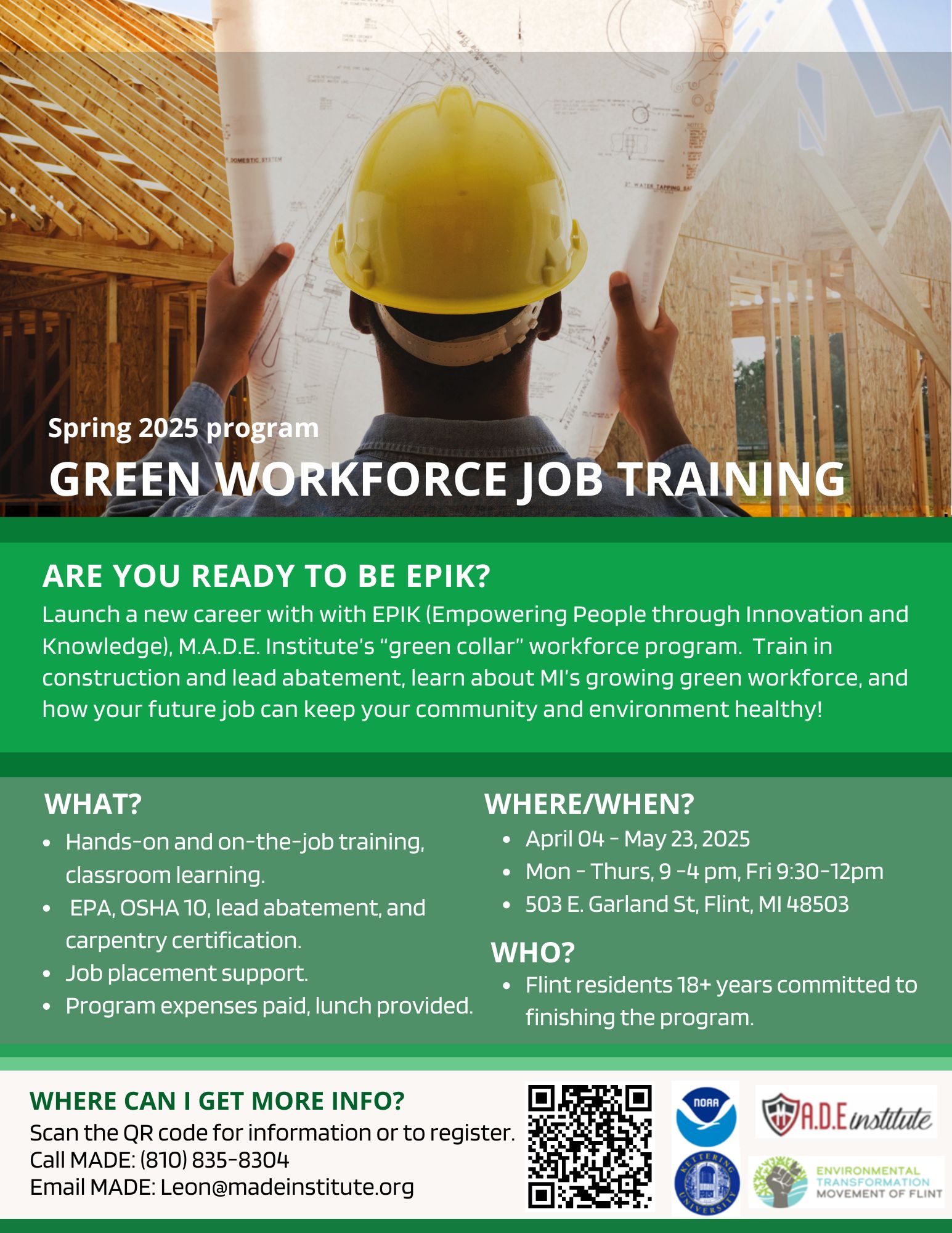MADE GREEN COLLAR ECONOMY

Made green collar economy
Empowering through Innovation and Knowledge (EPIK) Green Workforce Development Program
Investments in the green workforce and the green economy means more green jobs are coming to Michigan! The green workforce describes jobs that produce goods or services that help protect the natural environment. Carpenters, construction contractors and laborers, HVAC and electricity technicians, and insulation installers are just a few examples of jobs that are changing the materials and techniques they use to ensure that their work reduces energy use, plastic use, and air and water pollution.
Prepare to be part of the green workforce wave by expanding your skills, knowledge and resume with Empowering People through Innovation and Knowledge (EPIK), The M.A.D.E. Institute’s “green collar” workforce program. This program is funded by the National Atmospheric and Oceanic Administration (NOAA) and will combine hands-on and on-the-job training in green carpentry and lead abatement with classroom environmental literacy instruction to help you become competitive in the job market.
How long is the program? What can I expect?
- The program is 8 weeks long, from April 04 – May 23, 2025.
- Weekly schedule: Mon-Thurs, 9:00 a.m. – 4:00 p.m. and Fri, 9:30 a.m. – 12:00 p.m.
- Lunch is provided.
- From Monday to Thursday, you will experience hands-on and on-the-job training in carpentry skills and lead abatement. Fridays will include interactive classroom learning about environmental and climate-related topics to give you a strong foundation of knowledge for entering the green workforce and setting yourself apart as a candidate for green jobs.
- You will learn in a small, motivated cohort guided by a dedicated, Flint-based team of green workforce industry experts and climate resilience instructors.
What certification will I receive? What will I learn?
- You will receive EPA, OSHA 10, and lead abatement certification, which will show employers your training in carpentry, understanding of common safety and health hazards on the job, and ability to perform lead abatement inspection and assessment.
- Training that you will encounter in the hand-on learning portion of this program include carpentry, drywall finishing, window replacement, painting, trim and siding, and lead abatement.
- Topics that you will encounter in the classroom portion of this program include: the future of the green workforce (i.e. what kinds of green jobs are out there); Michigan’s changing weather; the urban heat island effect and why and how to ensure your heat safety when working outside in hot temperatures; the connection between community health and water and air quality; how green infrastructure and energy efficient projects enhance community well-being; the importance of using passive solar design strategies in home building; recycling and reuse of construction and carpentry materials for environmental health.
Do I need to pay for the program? Or will I receive compensation of some kind?
- No, all program expenses are paid for, including an individual toolkit that each participant will receive for their hard-skills training sessions
- All participants will receive a stipend included to support travel to and from sessions
Where is the training located?
- Both hands-on training and classroom learning will take place in person in Flint at The MADE Institute’s headquarters at 706 Church St, Flint, MI 48502.
Am I eligible to apply?
You are eligible to apply if you are:
- Living in Flint and 18 years or older by the start of the program.
- Interested in entering the green construction, recycling, and/or renewable/clean energy industry workforce upon completion of the course.
- Interested in understanding why the green workforce is important to social and environmental health.
- Interested in understanding how energy efficient infrastructure can prepare communities for harsh weather.
- Able to attend the program on time every day for 8 weeks and stay for the entirety of scheduled sessions.
- Willing to engage in conversation with others.
- Have a grasp of basic math concepts (e.g. calculate the average number from a group of numbers) and basic writing abilities.
Where do I sign up for EPIK?
- Fill out an intake form to sign up for the program.
- You can access the intake form by:
- Visiting The MADE Institute’s green collar webpage https://madeinstitute.org/made-green-collar-economy/
- Calling The M.A.D.E. Institute at (810) 835-8304
- Emailing The M.A.D.E. Institute at Leon@madeinstitute.org
- Visiting The M.A.D.E. Institute at 706 Church St, Flint, MI 48502
Who do I contact for more information?
- Call The MADE Institute at (810) 835-8304
- Email Leon El-Alamin at Leon@madeinstitute.org
EPIK is collaboratively developed and taught by The MADE Institute, Environmental Transformation Movement of Flint, and Kettering University as part of Climate Resilient Flint, a project funded by NOAA’s Environmental Literacy Program.

MADE Green Collar Economy is a blueprint to upgrade Industrial Blue Collar employment to better respect the environment. The Jobs Of Tomorrow-Today! The MADE Institute Green Collar Economy vision is to look at the urban community and see a new reality that will use the resources of an undeserved community and underutilized land and blighted buildings to create thriving communities.
So who will do the hard work of actually building the green economy? The answer: millions of ordinary people, many of whom do not have good jobs right now even with having college degrees. According to the National Renewable Energy Lab, the major barriers to a more rapid adoption of renewable energy and energy efficiency are not financial or legal but the lack of trained, green-collar workers to do all the jobs.
THE MADE INSTITUTE
MADE Green Collar Economy…Creating Job’s …Restoring Dignity and Protecting the Earth.
That is good news for people returning home from prison, looking for a second chance. That is good news for people in urban and rural communities who are suffering from chronic lack of work. That is good news for our veterans coming home from decades of fighting in wars. The MADE Green Collar Economy would create opportunities for work and wealth creation in today’s recovering economy.
Examples of green collar jobs, electricians who install solar panels; plumbers who install solar water heaters; farmers engaged in organic agriculture and some bio-fuel production; and construction workers who build energy-efficient green buildings, wind power farms, solar farms. Other examples of using today’s technology in the green economy is a calking gun. Hundreds of thousands of green-collar jobs be weatherized and energy-retrofitting every building in the United States.
Building with leaky windows, ill-fitting doors, poor insulation, outdated furnaces, and old appliances can gobble up 30 percent more on their heating bills. The point is this. The conditions of joblessness and poverty is what creates the out of control crime problem urban communities face today. By adopting the Green Collar Economy we could rebuild communities that thrive.


